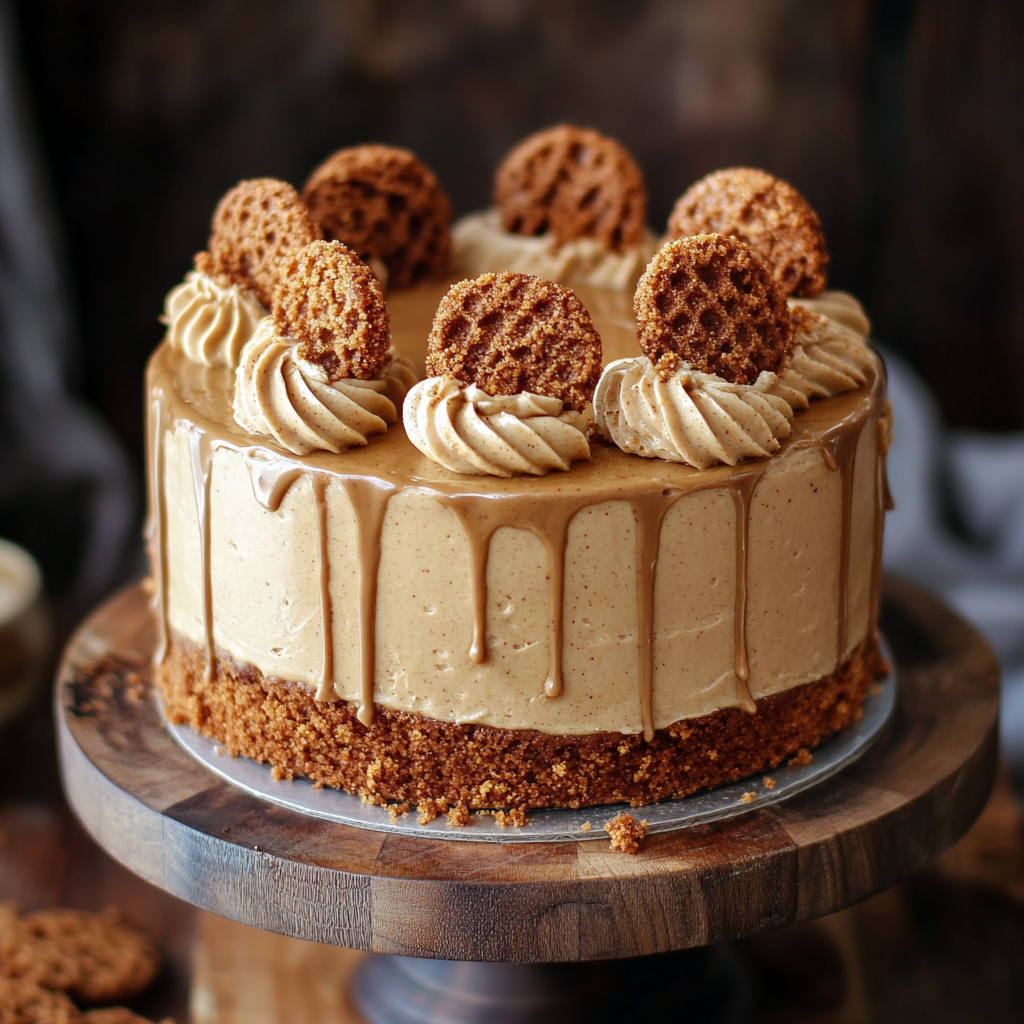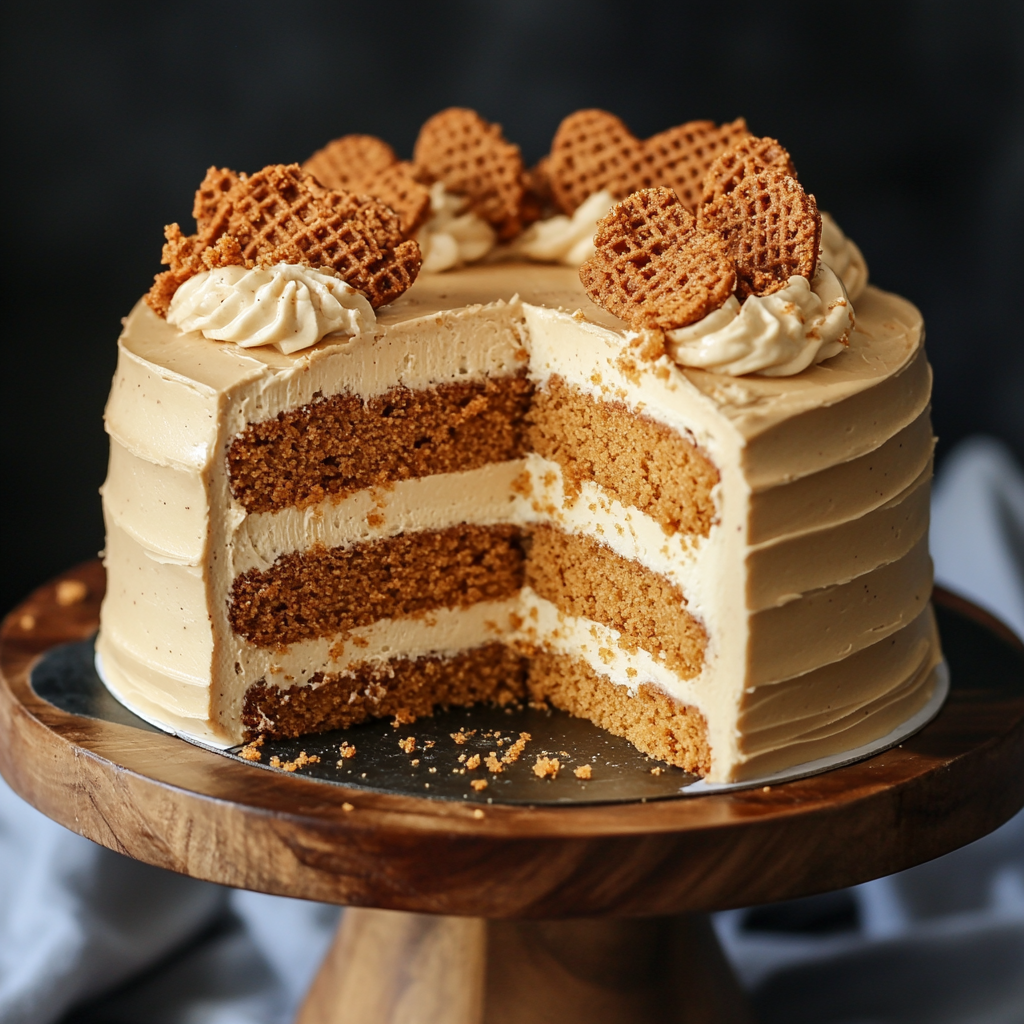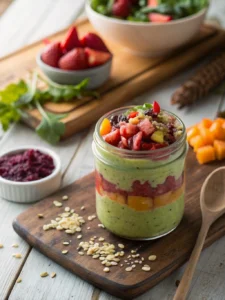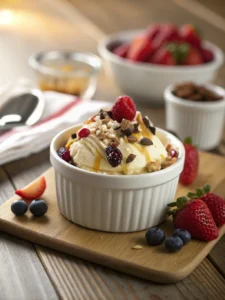Imagine biting into a slice of cake that tastes like warm, spiced cookies. That’s what Biscoff cake is all about. It turns cookie butter’s rich flavor into something truly special. Whether it’s for a big celebration or just a cozy treat, this cake combines childhood memories with a sophisticated twist.
This guide takes you from Belgian cookies to a global baking sensation. You’ll see how Biscoff’s cinnamon-kissed taste becomes a stunning cake. Home bakers and chefs love its creamy texture and the crunch of Biscoff cookies in every bite.
Key Takeaways
- Learn how Biscoff’s signature spiced flavor becomes the star of both the cake layers and frosting.
- Discover essential ingredients like Lotus Biscoff spread and tips to avoid common baking pitfalls.
- Understand why cookie butter cake trends dominate dessert menus nationwide.
- Explore vegan and gluten-free adaptations that keep this treat inclusive.
- Master storage techniques to keep your biscoff cake fresh for days.

What Is Biscoff Cake?
Biscoff cake, also known as lotus cake, turns the beloved Biscoff cookie into a layered dessert. It mixes the cookie’s spices into batter, frosting, or even crumb layers. Let’s explore its origins and why it’s so popular.
The Origin of Biscoff Cookies
Belgium’s speculoos cookies have a long history, but the modern version started in the 1930s. Lotus Bakeries in Belgium created them. Their unique flavors of cinnamon, clove, and brown sugar became a favorite with coffee lovers in Europe.
When they came to the U.S., they were renamed Biscoff. They quickly spread around the world.
From Cookie to Cake: The Biscoff Evolution
Chefs began using Biscoff cookies in cake bases or mixing them into batters. The Biscoff spread, a gooey caramel-like ingredient, became essential for frosting and fillings. Now, you can find recipes from simple sheet cakes to towering birthday cakes, all with that special spice blend.
Why Biscoff Cake Has Become So Popular
Its charm comes from the perfect mix of caramel sweetness and warm spices like nutmeg and cinnamon. Social media loves its stunning designs. The Biscoff spread makes baking easier. Whether for a party or a quick snack, its versatility keeps it in the spotlight.
Essential Ingredients for Your Biscoff Cake
Making the perfect biscoff cake begins with the right ingredients. Each part is crucial for flavor and texture. You’ll need all-purpose flour, granulated sugar, eggs, and butter. Baking powder helps the cake rise.
- Biscoff Cookie Butter: This caramel-hued spread is the star. Use cake with biscoff made from authentic Lotus Biscoff Spread for real flavor.
- Crushed Biscoff Cookies: Crushed Lotus Biscoff Cookies add texture and deepen the cookie butter taste. Use them in layers or as a topping.
- Room-Temperature Butter: Softer butter mixes better with sugar, making the batter smooth.
Quality is key. Choose high-fat butter for tenderness and fresh baking powder. Coconut oil is a good substitute, but avoid low-fat spreads. They can weaken the taste. Always use ingredients at room temperature to avoid lumps.
“The secret is in the balance—Biscoff’s sweetness needs the right foundation to shine,” say chefs at The Dutch Bakery, creators of original Biscoff recipes.
If you’re avoiding dairy, section 7 has vegan swaps like plant-based butter. Always measure dry ingredients by weight for accuracy. With these basics, your cake with biscoff will have the right crumb and that iconic cookie butter aroma.
Tools and Equipment You’ll Need
Creating a biscoff cookie cake or cookie butter cake needs the right tools. Whether you’re experienced or new, the right equipment helps your cake turn out great. Here’s what you should get before starting.
Baking Essentials
These items are must-haves for any biscoff cookie cake project:
- 9-inch round cake pans: Use aluminum pans with removable bottoms for even layers. Make sure to grease them to avoid sticking.
- A stand mixer or handheld mixer: These mixers whip batter smoothly, preventing lumps in your cookie butter cake.
- Measuring cups and spoons: Use stainless steel sets for precise measurements.
- Rubber spatulas: These flexible scrapers are great for mixing and leveling batter in pans.
- Cooling racks: Place layers on these racks to cool upright and prevent sogginess.
- An oven thermometer: This ensures your oven’s temperature is accurate for even baking.
Optional Tools for Decoration
Enhance your biscoff cookie cake with these extras:
- Piping bags and tips: Ideal for detailed designs or filling layers.
- Offset spatula: This spatula helps smooth frosting edges and spreads glazes evenly.
- Cake turntable: Rotates your cake while decorating, making it easier.
- Cake combs: Use these to create ruffles or waves in frosting with ease.
If you don’t have specialized tools, don’t worry. You can use resealable plastic bags for piping. A plate and your hand can smooth tops if you don’t have a spatula. Remember, every pro started with the basics. Focus on the flavor and layers first.
Step-by-Step Biscoff Cake Recipe
Turn your ingredients into a rich biscoff cake with these steps. Pay attention to detail and timing for the perfect texture and taste.
Preparing Your Ingredients
Begin by setting up your workspace. Make sure everything is ready before you start mixing:
- Measure flour, sugar, and baking powder into separate bowls.
- Sift dry ingredients together to eliminate clumps.
- Bring butter and eggs to room temperature to avoid lumps in the batter.
Tip: Chill overmixed batter briefly to prevent overdevelopment.
Making the Biscoff Cake Batter
Make a light and airy base with these steps:
- Cream softened butter with ½ cup Biscoff spread until smooth (2-3 minutes).
- Add eggs one at a time, mixing until fully incorporated.
- Alternate adding dry ingredients and milk in three parts to prevent separation.
“Overmixing leads to dense layers—stop blending once combined,” advises pastry chefs.

Baking Your Cake to Perfection
Bake in a preheated 350°F oven for 25-30 minutes. Check doneness with a toothpick inserted into the center. Let layers cool completely on a rack before frosting to prevent sogginess.
Creating the Biscoff Frosting
Whip ⅓ cup Biscoff spread with softened butter until creamy. Gradually add powdered sugar and milk to reach a spreadable consistency. Apply to cooled layers using an offset spatula for an even finish. This frosting enhances the cake with biscoff’s caramel notes.
How to Decorate Your Biscoff Cookie Cake
Turn your homemade biscoff cookie cake into a masterpiece with these decoration tips. Begin with a thin crumb coat to lock in moisture. Then, layer frosting for a smooth or textured finish. For a rustic vibe, leave crumbs visible under the frosting for depth.
- Simple Drips: Melt Biscoff spread in a microwave-safe bowl. Drizzle it over the frosted cake with a spoon, tilting the plate to spread the warm mixture.
- Cookie Texture: Crush Biscoff cookies finely and press them into the frosting for a crunchy, flavorful crust. Use whole cookies as edible toppers for a classic touch.
- Piping Designs: Fill a piping bag with frosting and pipe rosettes, zigzags, or borders. Use a star tip for intricate patterns that complement the cake’s rich flavor.
Choose colors like caramel, amber, or dark chocolate to match the cake’s warm tones. For holidays, add green/red sprinkles or gold leaf. For birthdays, sprinkle edible glitter or write messages with a food pen.
Pro tip: Use an offset spatula to smooth edges and drag a bench scraper for clean lines. Let frosting set in the fridge for 15 minutes between layers. For a lotus cake that dazzles, arrange fresh berries or chocolate shavings around the base on a decorative plate.
Try contrasting designs—pair a glossy drip with crushed cookies for texture. Whether it’s rustic or sleek, these methods make your cake stunning.
Delicious Variations of Cookie Butter Cake
Want to make your biscoff cake even better? Try these creative ideas to enjoy cookie butter cake in new ways. They keep the caramel-hazelnut flavor you love.
Biscoff Cheesecake Fusion
Combine creamy cheesecake with biscoff cake for a rich dessert. Here are some ideas:
- No-bake versions using chilled cookie butter cheesecake filling
- Layered cakes with alternating biscoff cake and cheesecake batters
- Swirls of cookie butter spread into cheesecake batter for marbled effects
Vegan Biscoff Cake Options
Make your cake plant-based with these swaps:
- Swap butter for coconut oil or vegan margarine
- Replace eggs with flaxseed “eggs” (1 tbsp ground flax + 3 tbsp water per egg)
- Use almond milk or oat milk instead of dairy milk
Pro tip: Make sure all ingredients are vegan, including your cookie butter spread.
Gluten-Free Adaptations
For gluten-free bakers, try these:
- Regular flour with a gluten-free all-purpose blend
- Biscoff cookies with gluten-free cookies (if available) or omit entirely
- Add xanthan gum to prevent crumbliness
Note: Cookie butter itself is gluten-free, but check labels for cross-contamination warnings.
Try seasonal twists like pumpkin-spiced cookie butter cake in fall or peppermint versions for holidays. Mini cupcake formats are great for tasting parties. Each adaptation should keep that rich Biscoff taste. Adjust leavening agents when using gluten-free flours to keep the cake moist and tender.
Common Mistakes When Making Biscoff Cake
Making a biscoff cake requires careful attention. To avoid common mistakes, follow these tips to keep your cake moist and full of flavor.
- Overmixing the batter: Stir too long and the batter becomes tough. Mix just until ingredients are combined for a light cake.
- Wrong oven temperature: A wrong oven temperature can mess up the texture. Always check with an oven thermometer before baking.
- Sloppy measurements: Use a scoop and level for dry ingredients. Weigh the Biscoff spread for the right amount—too much can make the cake soggy.
- Skipping proper creaming: Cream butter and sugar until fluffy. This step is key for a cake that rises well and tastes great.
- Opening the oven early: Opening the oven too soon can mess with the rising. Wait at least 20 minutes before checking your cake.
- Uneven cookie butter distribution: If not mixed right, cookie butter lumps can form. Fold it gently into the batter and frosting until it’s smooth.
By following these adjustments, your biscoff cake will be perfect. It will have the right balance of cookie butter richness and a tender crumb.
Pairing Suggestions for Your Lotus Cake
Make your biscoff cookie cake even better by pairing it with the right flavors. Choose drinks that balance its rich taste.
Beverages That Complement Biscoff Flavors
Pair your lotus cake with:
- Espresso or cappuccino to cut through sweetness.
- Chai or black tea with cinnamon notes for flavor harmony.
- Vanilla ice cream as a milk-based cooler.
- Spiced rum cream liqueur or ruby port wine for adult guests.
Dessert Table Combinations
Create balance on your dessert table:
- Lemon sorbet or berry compote for tart contrast.
- Spiced poached pears or gingerbread bites for complementary warmth.
- Fresh figs or strawberries for juicy freshness.
Serve slices at room temperature for the best texture. Add cinnamon dusting or edible flowers for a nice look. For a seasonal twist, try pumpkin spice in fall or peppermint in winter.
Storing and Preserving Your Cake with Biscoff
Keeping your cookie butter cake fresh is easy. Wrap cooled layers in parchment paper and then in an airtight container. It stays fresh for up to 2 days at room temperature. For longer storage, wrap slices in plastic and foil and refrigerate.
Thaw frozen portions at room temperature for 1-2 hours before serving. This way, your cake will be ready to enjoy.
“The Biscoff spread’s natural oils can cause frosting to soften over time,” warns pastry chef Emily Carter. “Always store in cool, dry conditions to maintain texture.”
- Room Temp: 2 days in airtight containers
- Refrigerate: 4-5 days wrapped in plastic
- Freeze: Up to 3 months in heavy-duty freezer bags
Freezing requires separating layers and frosting to avoid sogginess. Thaw completely before adding whipped cream or toppings. If the cake has crystallized spread or smells off, discard it.
For make-ahead, prepare batter a day early and bake just before serving. Always use clean utensils when handling stored cookie butter cake to avoid contamination.
By following these steps, you can enjoy your homemade cake with biscoff at its best, whether it’s the same day or later.
Troubleshooting Your Biscoff Cake
Even the most careful bakers can run into problems with their biscoff cake or biscoff cookie cake. Here are some tips to turn those mishaps into delicious desserts:
Fixing a Dry Cake
- Drizzle layers with Biscoff flavored simple syrup (equal parts water and sugar, spiked with cinnamon).
- Layer extra frosting between cake tiers to add moisture.
- Serve slices with a dollop of whipped cream to enhance moistness.
Salvaging Sunken Centers
“A sunken center doesn’t mean failure—it means reinvention.”
- Fill depressions with extra Biscoff spread or spiced buttercream.
- Cut the top layer into pieces and assemble as a trifle with yogurt.
- Brush the sunken area with coffee or rum syrup to lift texture.
Frosting Problems and Solutions
| Problem | Solution | Prevention |
|---|---|---|
| Separated frosting | Re-whip with 1 tsp Biscoff spread per cup of frosting | Cool butter to 65-70°F before mixing |
| Grainy texture | Beat in 1 tsp corn syrup or honey | Use room-temperature ingredients |
| Frosting melting | Re-chill layers briefly before piping details | Store in 68-72°F room |
Always line pans with parchment and test doneness with a toothpick. These fixes ensure every biscoff cookie cake becomes a triumph, no matter the hiccup!
Conclusion
Biscoff cake turns cookie butter into a stunning dessert for any celebration. It’s easy to make, with layers of spiced flavor and creamy frosting. Using real Biscoff spread ensures a moist and delicious cake every time.
Whether you call it Biscoff cake or lotus cake, it’s perfect for any occasion. You can even make it vegan or gluten-free. If you run into problems, the troubleshooting tips can help. Adding nuts or caramel drizzle makes it even more special.
Get ready to bake this amazing recipe. Share your creations online to inspire others. Biscoff cake is not just a dessert; it’s a way to celebrate and share joy.
FAQ
What makes Biscoff cake different from other cakes?
Biscoff cake stands out because of its rich, caramelized taste. This comes from Biscoff cookies and cookie butter. Its unique spice mix and buttery feel make it different from regular cakes.
Can I use other cookie spreads instead of Biscoff?
You can try other cookie spreads, but Biscoff is the best choice. It gives the cake its authentic flavor. Other spreads might change the taste a bit.
How should I store my Biscoff cookie cake?
Keep your Biscoff cake fresh by storing it in an airtight container. Do this at room temperature for up to three days. For longer storage, refrigerate or freeze it, making sure it’s wrapped well to avoid dryness.
Can I make a vegan Biscoff cake?
Yes! For a vegan Biscoff cake, use flax eggs instead of eggs and plant-based milk. Replace butter with vegan butter. This way, you can enjoy the cake while following a vegan diet.
What are some popular variations of cookie butter cake?
You can try Biscoff cheesecake fusion, gluten-free versions, or seasonal flavors like pumpkin or spiced apple. These variations let you customize your dessert and explore new tastes.



